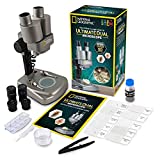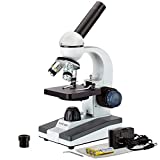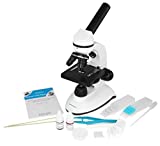Microscopes for beginners – Buying guide & Comparison
If you’re short on time and you just want to find the best microscope for beginners, this short paragraph should help you get exactly the model you need. According to our findings, the National Geographic Dual NGMICROSCOPE is the best because it fits any eager learner’s budget and does precisely what it has been designed to do. On the one hand, this unit can magnify the image of the specimen by 20 to 50 times depending on the circumstance and your momentary needs. In addition to all of this, it’s worth noting that the device comes with two illumination systems, one of which can be found below the sample and the other above. What’s more, this National Geographic option comes with a series of accessories ranging from ten prepared slides to a 23-slide storage container. If the National Geographic Dual NGMICROSCOPE is unavailable, your second option should be the AmScope M150C.
Comparison table
 Our Top Choice
Our Top Choice
As a rather budget-friendly choice, this model is a great alternative for children. Its magnification range is 20x to 50x so you won’t be able to use it for very small specimens. However, it might prove its worth as a stereomicroscope. The kit also contains a variety of accessories ranging from several blank slides to tweezers and a learning guide.
The magnification capabilities of this particular microscope might be less impressive when compared to those of others.
If you’re looking for a unit that doesn’t break the bank but gets the job done, this National Geographic one might be worth considering.
 2nd Best
2nd Best
The M150C is a monocular compound microscope, which means that it is designed to serve you under a myriad of circumstances. Its 40x to 1000x magnification range renders it particularly versatile, and the fact that it has been equipped with a 360-degree rotatable head makes it a good choice for educational purposes. It comes with built-in illumination.
It doesn’t seem to be as affordable as some other models we’ve stumbled upon while doing our research on the matter.
Should you be in the market for a real microscope designed for beginners, the AmScope M150C is likely to serve you as best as possible.
Also To Consider
For children and other users who have yet to master the skills required to properly use a microscope, the MFL-06 can prove to be a friend in need. It’s easy to use and convenient and comes with all the features you might need in a simple option. It can even be powered with batteries, which means that you can use it in the garden or wherever you feel like.
The maximum magnification capabilities of this unit go up to 400x, which means that it’s less suited for some biological samples.
As it is capable of offering you more than enough value for the money and it gets the job done precisely as it should, the MFL-06 deserves a bit of mulling over.
Purchasing the best beginner microscope these days might look like a daunting task as we have seen that the market appears to be overflowing with alternatives. This is the reason we have decided to give you a hand with selecting the right product for your specific needs. If you’re having trouble deciding on features, advantages, or various specifications that you ought to give some thought to, check out our comprehensive buyer’s guide.
Purpose
The first thing you must do is determine the purpose you are trying to achieve with the help of your new microscope. Are you looking to examine the structure and intricate appearance of bugs, coins, pieces of jewelry, and electronics components, or would you rather be interested in studying the way cells are grouped in certain tissues? This is a core question you have to ask yourself, what kind of needs do you have, do you want a portable microscope? You should know that you can get one and connect it to your smartphone and that there are some good options you can take a look at.
In addition to all of this, you will have to assess the degree of expertise of the person you are purchasing the device for. If you’re an adult, it goes without saying that you will have no trouble understanding the basics of using such a unit. On the other hand, if what you’re trying to do is buy the product for a child who’s interested in studying science, in general, you might have to reconsider the factors you have to bear in mind and concentrate on other aspects a little more.
Stereo vs. compound models
Despite the vast array of designs that are available out there, your decision will have to boil down to choosing a compound or a stereo microscope. What makes the difference between these two kinds of devices?
First of all, if you require a particular amount of space in order to take a peek at the specimen you’ll be examining, a compound model might not be the right solution to your problems. Typically, compound alternatives are used in laboratories where scientific activities happen on a regular basis, and so there’s a high chance that the person using the unit will try to look at slides instead of full-size objects.
Stereo microscopes are designed to be user-friendly. They don’t raise too many technical difficulties to first-time users, but the really neat thing about them is that you can use a broad range of subjects. Nevertheless, we feel compelled to point out that there are many differences between compound options and stereo alternatives, and the crucial one consists of the magnification capability.
Magnification
Even the best starter microscope should allow you to magnify the image by ten to twenty times. However, in certain cases, this type of magnification might not be enough. While it might pay off to invest in a portable microscope that enables you to transport and store it with ease, sometimes you might need a bit more power in this sense.
Once again, you have to look at your requirements and preferences. Studying strands of hairs is easy with the help of any stereo microscope, but going in-depth can only be done by using a compound one.
Lights
Most models that you are likely to stumble upon while prospecting the market will have some sort of illumination system or the other. While some units are capable of lighting your specimen from below, others also feature a bulb that can give you light from above.
Ancient microscopes used to come with a mirror that the user had to rely on in order to focus the fascicle on the specimen. Thanks to technological advances made in the last decades, this characteristic is now considered obsolete. Even so, it’s better to check for an illumination system and see whether or not the unit you’re thinking of buying is equipped with it.
5 Best Beginners’ Microscopes (Reviews) in 2024
Some of the best microscopes for beginners are showcased below. We have taken the time to look at the user feedback garnered by these models and have reached the conclusion that they’re critically acclaimed for several good reasons. They’re efficient and versatile and will allow you to benefit from an excellent performance.
Contents
1. National Geographic Dual LED Student Microscope

The magnification capabilities of this alternative range from 20x to 50x and this detail seems to be enough under most circumstances. Despite the fact that it does not have the traditional design of some stereo or compound models, this device is made with the needs of the user in mind.
That’s why the manufacturing brand has included a series of extras such as ten blank slides, tweezers, a cover, as well as a learning guide.
Furthermore, this is one of the few units that have been outfitted with two types of illumination, one of which can light your subject from below and the other from above.
Pros
This affordable model speaks to the needs of rookies who have acquired little to no experience when it comes to working with a microscope.
The model comes with a series of extras that you’d otherwise have to purchase separately. The kit includes a variety of accessories ranging from a 23-slide storage container to prepared and blank slides.
The optics of this alternative are made out of glass, so you have nothing to worry about in terms of the performance of the device.
Given the unique design of this product, you can use it as a convenient stereomicroscope and look at a variety of specimens, be they bigger or smaller.
Cons
Some parents have reported that handling the unit might be a bit too complicated for a child of the age of six.
There are only two magnification powers you can use; 20x and 50x. In this respect, the model might seem limited compared to others.
Buy from Amazon.com
2. AmScope M150C-I 40X-1000X All-Metal Optical Glass Lenses

In other words, it is designed for scientific purposes. You’ll encounter no difficulties when examining your slides with the help of the M150C.
The monocular design might make the AmScope unit stand aside from the crowd, but even on this account, this unit is a winner. The 360-degree rotatable head allows you to show what you’ve found to a colleague or friend.
What’s more, the magnification capabilities make this unit stand out from the crowd as you’ll be able to rely on its 40x to 1000x settings. The LED illumination system can be powered either by using a typical outlet or three standard AA batteries.
Pros
This monocular compound microscope is destined for those who have had a try at working with such a device in the past. However, it can be used with ease especially as it comes with straightforward instructions.
As the model is designed for basic scientific purposes, it makes the perfect choice for busy labs where some samples have to be examined in a timely fashion.
When it comes to the matter of whether or not the M150C makes a good alternative for educational purposes, it’s worth noting that the unit boasts a rotatable head. This feature will allow you to show to your students or kids the tiny mysteries you’ve found.
The 40x to 1000x magnification range is an advantage in itself as it will allow you to work with a broad array of specimens.
Cons
It’s a bit less affordable than some of its competitors.
Some buyers say that they wished the device had been equipped with a more powerful LED light.
Buy from Amazon.com
3. C & A Scientific MFL-06 My First Lab Duo-Scope

Aside from this minor inconvenience, this product is surely worth the bang for the buck. It’s a great addition to the kit of any eager beginner, especially as it has been constructed using high-quality materials and features real glass optics.
Moreover, this microscope can be powered using batteries, which means that you won’t be restricted to using it in just one room in your lab or home.
You can even take it outside in the garden with you and look at bugs and plants in their natural environment. As is the case with other choices out there, this one comes with a LED illumination system.
Pros
As one of the most budget-friendly choices in this line, the MFL-06 allows you to avoid breaking the bank. It does, however, come with most of the features you might need from a reasonably priced alternative.
The maximum magnification power that you’ll be able to use with this device is 400x.
Because it is made out of good-quality materials and boasts glass optics, you’ll be able to utilize the product for a more than decent amount of time.
The LED illumination system that the model has been outfitted with will allow you to glance at your samples both clearly and efficiently.
Cons
Various owners argue that this is a basic unit that can’t be used in too many scientific situations.
The accessories included in the box are somewhat basic, despite the fact that the package includes a dust cover and a plethora of other extras.
Buy from Amazon.com
4. Balance Living Microscope Set

Some parents aren’t particularly keen on the idea of investing a high sum on such a device, and that’s only understandable as nobody knows whether their children will, in actuality, peak an interest for this field.
Surprisingly enough, the CUL-10310 has more than decent magnification abilities which range from 120x to 1200X. Besides, the model is compact and versatile and can be taken everywhere you go.
Also, it should be noted that a generous accessory kit is part of the deal.
Seeing how this unit usually costs less than forty dollars, it might be worth considering for people who are on a budget. The Balance Living CUL-10310 comes with a built-in LED light at the bottom of its structure.
Pros
In spite of its rather basic design, the CUL-10310 manages to offer the benefits of a magnification range of 120x to 1200x. This renders the device quite versatile as there won’t be anything stopping you from glancing at a broad array of samples.
The portable design of this choice makes it convenient as users will be able to carry it with ease and wherever its services might be required.
It’s one of those affordable choices that include many accessories and a storage case.
Based on what we have found about it, it appears that the microscope is rather easy to put together thanks to the comprehensive instructions you’ll find in the box.
Cons
The lens can sometimes be somewhat cloudy and less clear than some buyers might want it to be.
In order to focus the image, you may have to make a bit of an effort, but several owners may argue that this is the only way that kids can actually learn how to operate a microscope.
Buy from Amazon.com
5. AmScope 40X-1000X Dual LED Light Student Microscope Package

The five magnification settings available on this unit are easy to recognize as we’ve tackled them while describing the formerly mentioned AmScope model.
As such, with the help of this unit, you will benefit from the freedom of relying on the 40x, 100x, 250x, 400x, or 1000x magnifications, depending on your preferences and samples.
A transmitted LED illumination system can be found to be part of the construction of this alternative, which is always a reassuring factor to mull over given that older models lack this particular feature.
While some owners have complained about the inability to connect the microscope to a computer or laptop, we’ll say that what you get is what you pay for. Given that it costs less than ninety dollars, it offers plenty of advantages.
Pros
This model is a convenient addition to any home or lab as it has been described as a user-friendly device for parents who homeschool their children and an even more efficient option for basic biology laboratories.
There are five magnification settings you will be able to use with this alternative, which means that you can make the most of it by using it for many types of samples.
The construction of the unit boasts an integrated LED illumination system that will enable you to analyze the specimens with ease.
It’s a portable choice as it can be used with a typical outlet or standard batteries; what this means for you is that you can take it with you virtually anywhere.
Cons
The model cannot be connected to a storing device, laptop, or computer, so there’s no way of transferring the images and saving them for later use.
Buy from Amazon.com
Bibliography:
1) What is the field of view in a microscope
3) Microscope basics – overview
4) The microscope – wikipedia.org












